Effect of Initial Conditions on the Pore Structure and Bimodal Soil–Water Characteristic Curve of Compacted Granite Residual Soil
Abstract
:1. Introduction
2. Materials and Methods
2.1. Materials
2.2. Test Method
3. Results and Discussions
3.1. Effect of the Initial Conditions on the Pore Structure
3.1.1. Pore Size Distribution Curves
3.1.2. Pore Size Distribution Indexes
3.2. Effect of the Initial Conditions on the SWCC
3.2.1. Determination of the SWCC
3.2.2. Effects of the Initial Conditions on the SWCC
3.2.3. Correlation between Pore Structure and SWCC
3.3. Determination of the 3D Bimodal SWCC Equation
4. Conclusions
- The tested granite residual soil presents a bimodal pore size distribution and bimodal SWCC for all the initial conditions, demonstrating a clear correlation between pore structure and SWCC variations.
- The size and volume of inter-aggregate pores change noticeably with the initial conditions, leading to changes of the SWCCs within the low- and middle-suction range. In contrast, intra-aggregate pores remain relatively unchanged, resulting in less pronounced differences in SWCCs within the high-suction range.
- Incomplete filling of aggregates by adsorbed water leads to noticeable changes in pintra values, and the SWCC is significantly affected by the compaction energy. After the saturation of aggregates, the stabilized pore structure reduces sensitivity of the SWCC to the compaction energy.
- The proposed 3D bimodal SWCC model captures the main characteristics and variations of SWCCs among initial conditions in the Sr-s-e0 space and exhibits strong agreement with laboratory test data (R2 > 0.98).
Author Contributions
Funding
Data Availability Statement
Conflicts of Interest
Abbreviations
| 3D | three-dimensional |
| MIP | mercury intrusion porosimetry |
| MP | modified proctor |
| OMC | optimum moisture content |
| PSD | pore size distribution |
| RH | relative humidity |
| RP | reduced proctor |
| SEM | scanning electronic microscope |
| SP | standard proctor |
| SWCC | soil–water characteristic curve |
| XRD | X-ray powder diffraction |
References
- Yao, Y.S.; Ni, J.J.; Li, J. Stress-dependent water retention of granite residual soil and its implications for ground settlement. Comput. Geotech. 2021, 129, 103835. [Google Scholar] [CrossRef]
- Luan, S.; Wang, F.; Wang, T.; Zhao, L.; Shui, E. Characteristics of gravelly granite residual soil in bored pile design: An in-situ test in Shenzhen. Adv. Mater. Sci. Eng. 2018, 7598154. [Google Scholar] [CrossRef]
- Zhao, Y.R.; Sun, X.H.; Wen, T.D.; Chen, R.; Huang, L. Micro-structural evolution of granite residual soil under external loading based on X-ray micro-computed tomography. KSCE J. Civ. Eng. 2021, 25, 2836–2846. [Google Scholar] [CrossRef]
- Mohsen, A.; Ramadan, M.; Gharieb, M.; Yahya, A.; Soltan, A.M.; Hazem, M.M. Rheological behaviour, mechanical performance, and anti-fungal activity of OPC-granite waste composite modified with zinc oxide dust. J. Clean. Prod. 2022, 341, 130877. [Google Scholar] [CrossRef]
- Fredlund, D.G.; Rahardjo, H. Soil Mechanics for Unsaturated Soils; John Wiley & Sons: Hoboken, NJ, USA, 1993. [Google Scholar]
- Rahardjo, H.; Lim, T.; Chang, M.F.; Fredlung, D.G. Shear-strength characteristics of a residual soil. Can. Geotech. J. 1995, 32, 60–77. [Google Scholar] [CrossRef]
- Gan, J.K.M.; Fredlund, D.G. Shear strength characteristics of two saprolitic soils. Can. Geotech. J. 1996, 33, 595–609. [Google Scholar] [CrossRef]
- Romero, E.; Gens, A.; Lloret, A. Water permeability, water retention and microstructure of unsaturated compacted Boom clay. Eng. Geol. 1999, 54, 117–127. [Google Scholar] [CrossRef]
- Birle, E.; Heyer, D.; Vogt, N. Influence of the initial water content and dry density on the soil-water retention curve and the shrinkage behavior of a compacted clay. Acta Geotech. 2008, 3, 191–200. [Google Scholar] [CrossRef]
- Wang, K.; Hui, Y.; Zhou, C.; Li, X.; Rong, Y. Soil-water characteristic surface model of soil-rock mixture. J. Mt. Sci. 2023, 20, 2756–2768. [Google Scholar] [CrossRef]
- Williams, J.; Prebble, R.E.; Williams, W.T. The influence of texture, structure and clay mineralogy on the soil moisture characteristic. Soil Res. 1983, 21, 15–32. [Google Scholar] [CrossRef]
- Leong, E.C.; Rahardjo, H. Review of soil-water characteristic curve equations. J. Geotech. Geoenviron. Eng. 1997, 123, 1106–1117. [Google Scholar] [CrossRef]
- Xie, X.; Li, P.; Hou, X.K.; Li, T.; Zhang, G. Microstructure of compacted loess and its influence on the soil-water characteristic curve. Adv. Mater. Sci. Eng. 2020, 5, 3402607. [Google Scholar] [CrossRef]
- Romero, E.; Vaunat, J. Retention curves of deformable clays. In Experimental Evidence and Theoretical Approaches in Unsaturated Soils; CRC Press: Boca Raton, FL, USA, 2000; pp. 91–106. [Google Scholar]
- Ng, C.W.W.; Pang, Y.W. Influence of stress state on soil-water characteristics and slope stability. J. Geotech. Geoenvironmental Eng. 2020, 126, 157–166. [Google Scholar] [CrossRef]
- Ng, C.W.W.; Pang, Y.W. Experimental investigations of the soil-water characteristics of a volcanic soil. Can. Geotech. J. 2000, 37, 1252–1264. [Google Scholar] [CrossRef]
- Tarantino, A.; Tombolato, S. Coupling of hydraulic and mechanical behaviour in unsaturated compacted clay. Géotechnique 2005, 55, 307–317. [Google Scholar] [CrossRef]
- Xiao, T.; Li, P.; Pan, Z.; Hou, Y.; Wang, J. Relationship between water retention capacity and pore-size distribution of compacted loess. J. Soils Sediments 2022, 22, 3151–3165. [Google Scholar] [CrossRef]
- Guoquan, D.; Xia, B.; Junping, Y.; Jungao, Z. Bimodal SWCC and bimodal PSD of soils with dual-porosity structure. Math. Probl. Eng. 2022, 4052956. [Google Scholar]
- Tao, G.; Chen, Y.; Xiao, H.; Chen, Q.; Wan, J. Determining soil-water characteristic curves from mercury intrusion porosimeter test data using fractal theory. Energies 2019, 12, 752. [Google Scholar] [CrossRef]
- Barden, L.; Sides, G.R. Engineering behavior and structure of compacted clay. J. Soil Mech. Found. Div. 1970, 96, 1171–1200. [Google Scholar] [CrossRef]
- Sridharan, A.; Altachaeffl, A.G.; Diamond, S. Pore size distribution studies. J. Soil Mech. Found. Div. 1971, 97, 771–787. [Google Scholar] [CrossRef]
- Alonso, E.E.; Gens, A.; Josa, A. A constitutive model for partially saturated soils. Géotechnique 1990, 40, 405–430. [Google Scholar] [CrossRef]
- Sasanian, S.; Newson, T.A. Use of mercury intrusion porosimetry for microstructural investigation of reconstituted clays at high water contents. Eng. Geol. 2013, 158, 15–22. [Google Scholar] [CrossRef]
- Nowamooz, H. Effective stress concept on multi-scale swelling soils. Appl. Clay Sci. 2014, 101, 205–214. [Google Scholar] [CrossRef]
- Li, X.; Zhang, L.M. Characterization of dual-structure pore-size distribution of soil. Can. Geotech. J. 2009, 46, 129–141. [Google Scholar] [CrossRef]
- Satyanaga, A.; Rahardjo, H.; Leong, E.C.; Wang, J.Y. Water characteristic curve of soil with bimodal grain-size distribution. Comput. Geotech. 2013, 48, 51–61. [Google Scholar] [CrossRef]
- Zhao, Y.; Rahardjo, H.; Satyanaga, A.; Zhai, Q.; He, J. A General Best-Fitting Equation for the Multimodal Soil-Water Characteristic Curve. Geotech. Geol. Eng. 2023, 41, 3239–3252. [Google Scholar] [CrossRef]
- Tao, R.; Cao, Z.; Pan, Y. Effects of bimodal SWCC on unsaturated loess slope stability analysis. In Geo-Risk 2023: Developments in Reliability, Risk, and Resilience; Geotechnical Special Publication: Arlington, VA, USA, 2023; Volume 346, pp. 291–300. [Google Scholar]
- Vanapalli, S.K.; Fredlund, D.G.; Pufahl, D.E. The influence of soil structure and stress history on the soil-water characteristics of a compacted till. Géotechnique 1999, 51, 573–576. [Google Scholar] [CrossRef]
- Burger, C.A.; Shackelford, C.D. Evaluating dual porosity of pelletized diatomaceous earth using bimodal soil-water characteristic curve functions. Can. Geotech. J. 2001, 38, 53–66. [Google Scholar] [CrossRef]
- Gould, S.; Rajeev, P.; Kodikara, J.; Zhao, X.L.; Burn, S.; Marlow, D. A new method for developing equations applied to the water retention curve. Soil Sci. Soc. Am. J. 2012, 76, 806–814. [Google Scholar] [CrossRef]
- Van Genuchten, M.T. A closed-form equation for predicting the hydraulic conductivity of unsaturated soils. Soil Sci. Soc. Am. J. 1980, 44, 892–898. [Google Scholar] [CrossRef]
- Fredlund, D.G.; Xing, A.Q. Equations for the soil-water characteristic curve. Can. Geotech. J. 1994, 31, 521–532. [Google Scholar] [CrossRef]
- Gallipoli, D.; Wheeler, S.J.; Karstunen, M. Modelling the variation of degree of saturation in a deformable unsaturated soil. Géotechnique 2003, 53, 105–112. [Google Scholar] [CrossRef]
- Tarantino, A. A water retention model for deformable soils. Géotechnique 2009, 59, 751–762. [Google Scholar] [CrossRef]
- Salager, S.; El Youssoufi, M.S.; Saix, C. Definition and experimental determination of a soil-water retention surface. Can. Geotech. J. 2010, 47, 609–622. [Google Scholar] [CrossRef]
- Zhou, W.H.; Yuen, K.V.; Tan, F. Estimation of soil-water characteristic curve and relative permeability for granular soils with different initial dry densities. Eng. Geol. 2014, 179, 1–9. [Google Scholar] [CrossRef]
- Wijaya, M.; Leong, E.C. Modelling the effect of density on the unimodal soil-water characteristic curve. Géotechnique 2017, 67, 637–645. [Google Scholar] [CrossRef]
- JTG 3430-2020; Test Methods of Soils for Highway Engineering. Research Institute of Highway Ministry of Transport: Beijing, China, 2020. (In Chinese)
- Ramadan, M.; Kohail, M.; Abadel, A.A.; Alharbi, Y.R.; Tuladhar, R.; Mohsen, A. De-aluminated metakaolin-cement composite modified with commercial titania as a new green building material for gamma-ray shielding applications. Case Stud. Constr. Mater. 2022, 17, e01344. [Google Scholar] [CrossRef]
- Mohsen, A.; Kohail, M.; Abadel, A.A.; Alharbi, Y.R.; Nehdi, M.L.; Ramadan, M. Correlation between porous structure analysis, mechanical efficiency and gamma-ray attenuation power for hydrothermally treated slag-glass waste-based geopolymer. Case Stud. Constr. Mater. 2022, 17, e01505. [Google Scholar] [CrossRef]
- Mohsen, A.; Amin, M.S.; Waly, S.A.; Ramadan, M. Rheological behavior, mechanical properties, fire resistance, and gamma ray attenuation capability for eco-friendly cementitious mixes incorporating thermally treated lead sludge. Constr. Build. Mater. 2022, 359, 129479. [Google Scholar] [CrossRef]
- ASTM D 5298-16; Standard Test Method for Measurement of Soil Potential (Suction) Using Filter Paper. ASTM International: West Conshohocken, PA, USA, 2016.
- Blatz, J.A.; Cui, Y.J.; Oldecop, L. Vapour Equilibrium and Osmotic Technique for Suction Control. Geotech. Geol. Eng. 2008, 26, 661–673. [Google Scholar] [CrossRef]
- Aldaood, A.; Bouasker, M.; Al-Mukhtar, M. Soil-water characteristic curve of lime treated gypseous soil. Appl. Clay Sci. 2014, 102, 128–138. [Google Scholar] [CrossRef]
- Tarantino, A.; De, C.E. Compaction behaviour of clay. Géotechnique 2008, 58, 199–213. [Google Scholar] [CrossRef]
- Alonso, E.E.; Pinyol, N.M.; Gens, A. Compacted soil behaviour: Initial state, structure and constitutive modelling. Géotechnique 2013, 63, 463–478. [Google Scholar] [CrossRef]
- Rosone, M.; Farulla, C.A.; Ferrari, A. Shear strength of a compacted scaly clay in variable saturation conditions. Acta Geotech. 2016, 11, 37–50. [Google Scholar] [CrossRef]
- Delage, P.; Audiguier, M.; Cui, Y.J.; Howat, M.D. Microstructure of a compacted silt. Can. Geotech. J. 1996, 33, 150–158. [Google Scholar] [CrossRef]
- Zhou, A.N.; Huang, R.Q.; Sheng, D.C. Capillary water retention curve and shear strength of unsaturated soils. Can. Geotech. J. 2016, 53, 974–987. [Google Scholar] [CrossRef]
- Li, X.; Li, J.H.; Zhang, L. Predicting bimodal soil-water characteristic curves and permeability functions using physically based parameters. Comput. Geotech. 2014, 57, 85–96. [Google Scholar] [CrossRef]
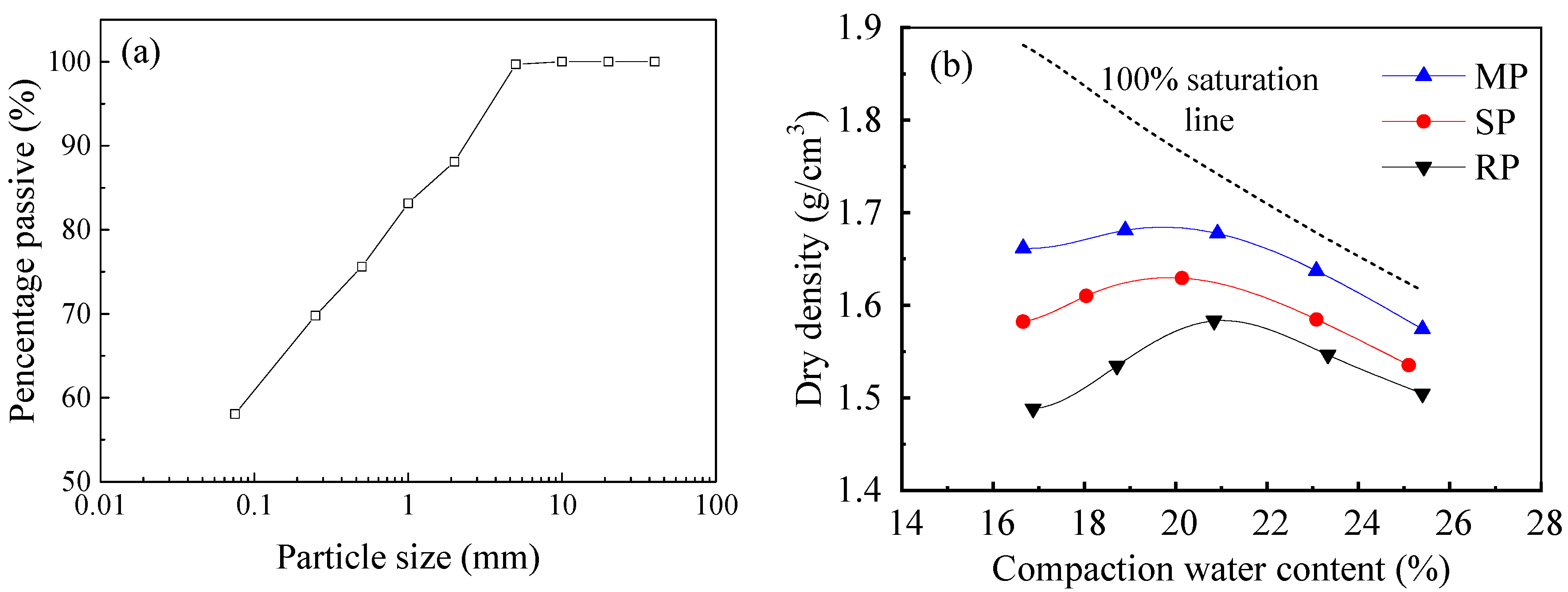
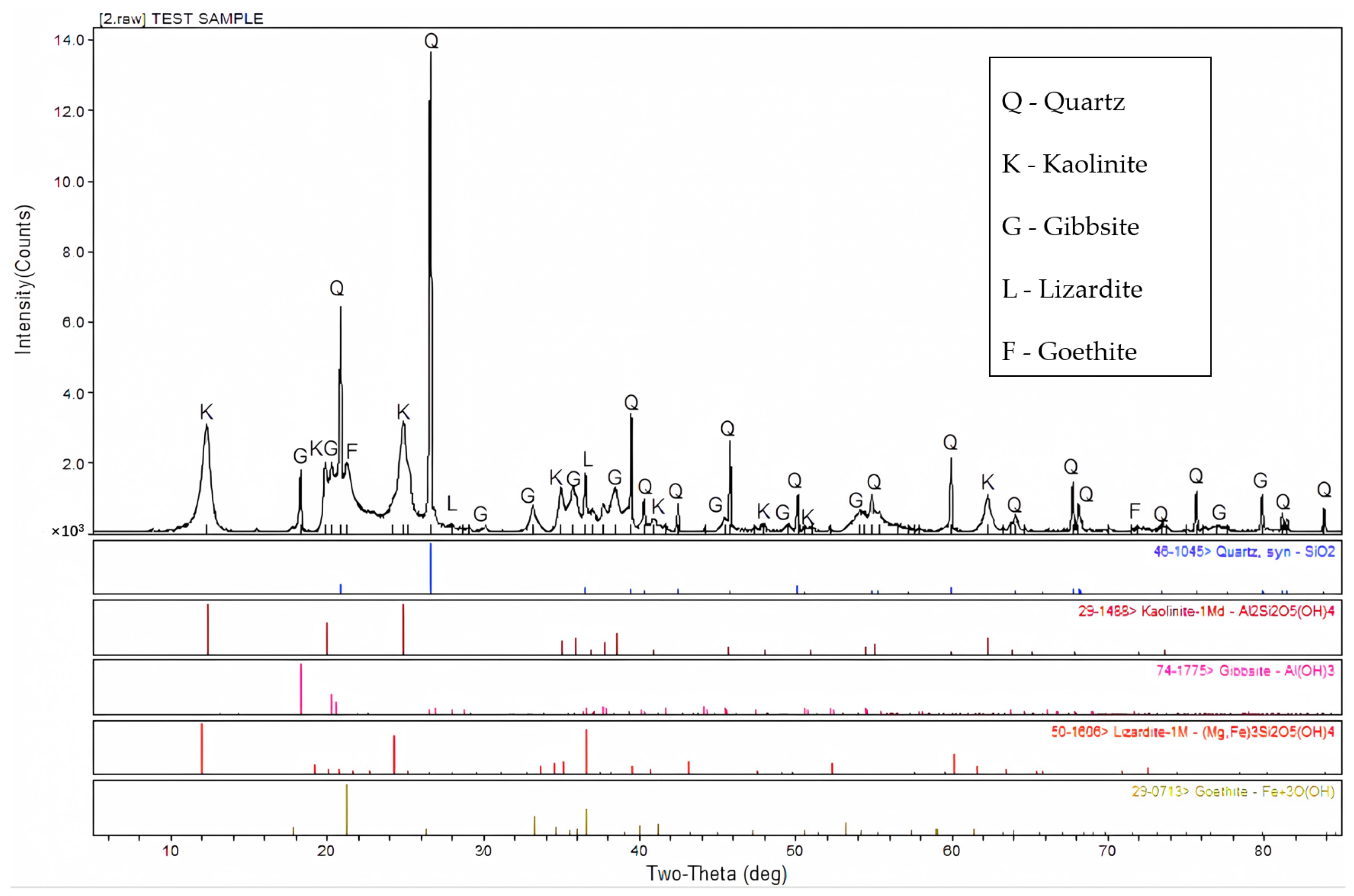

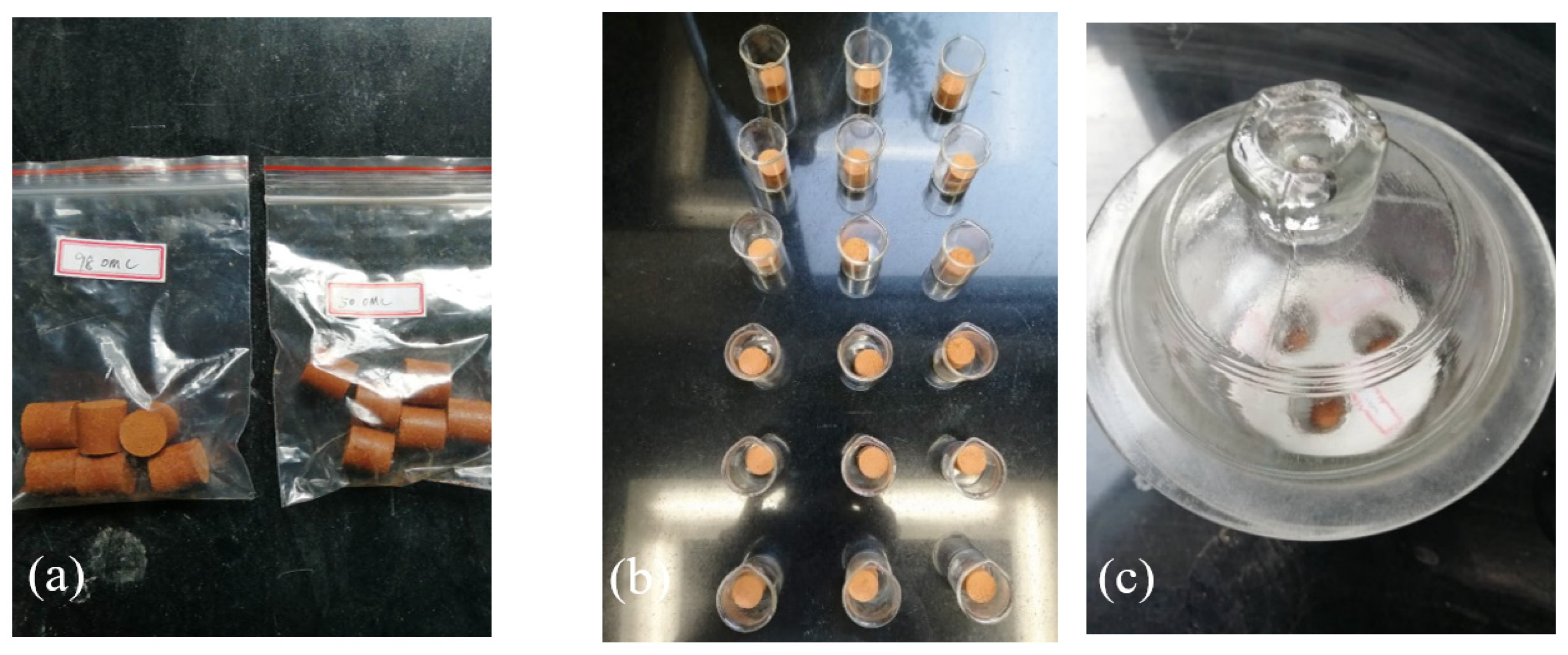
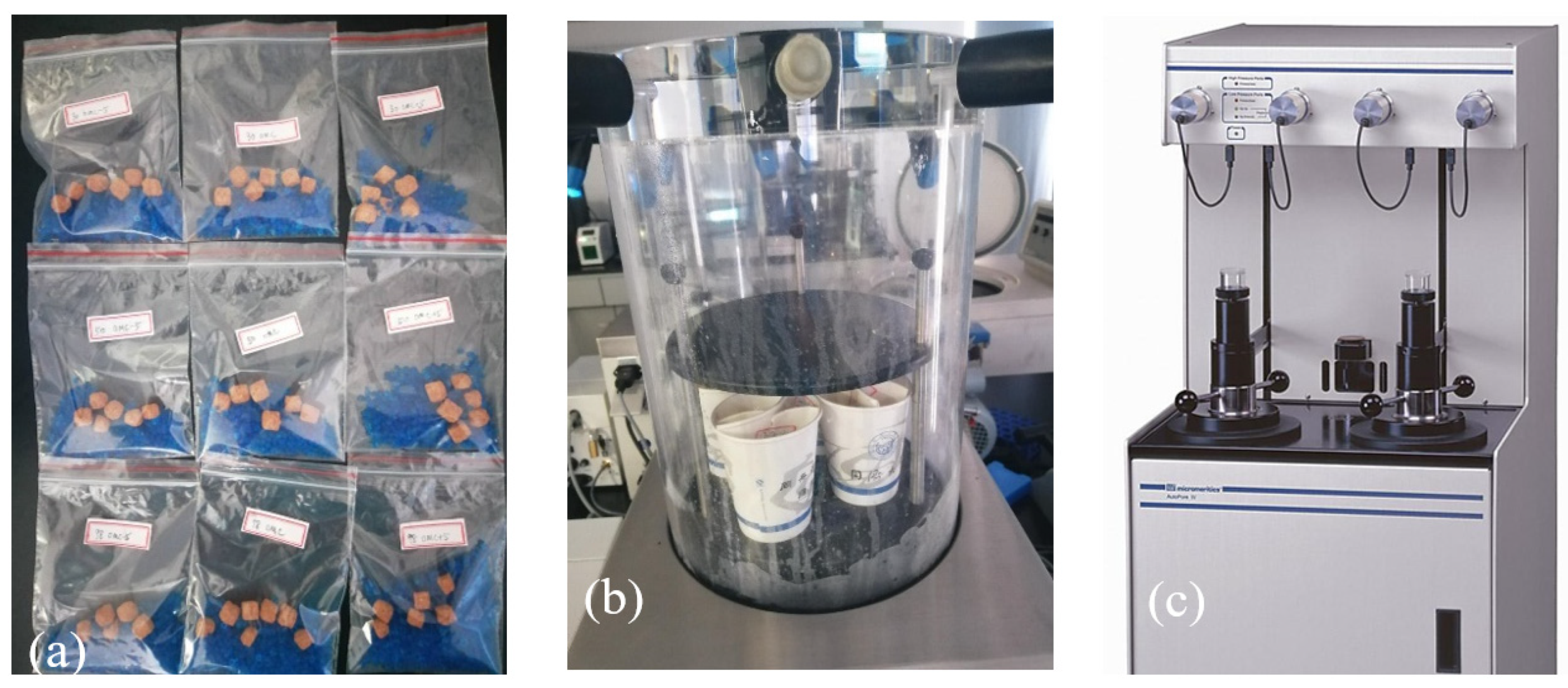
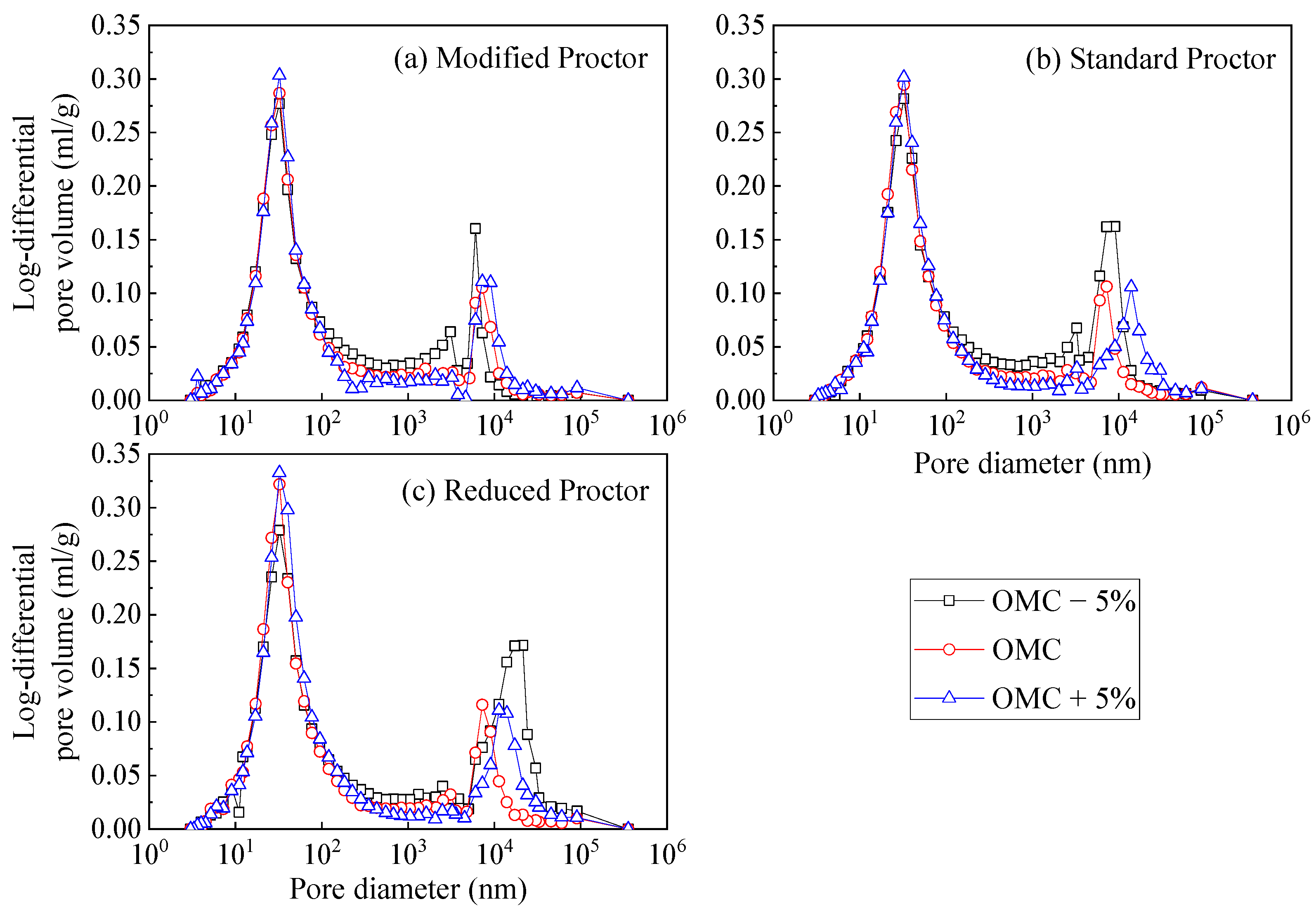


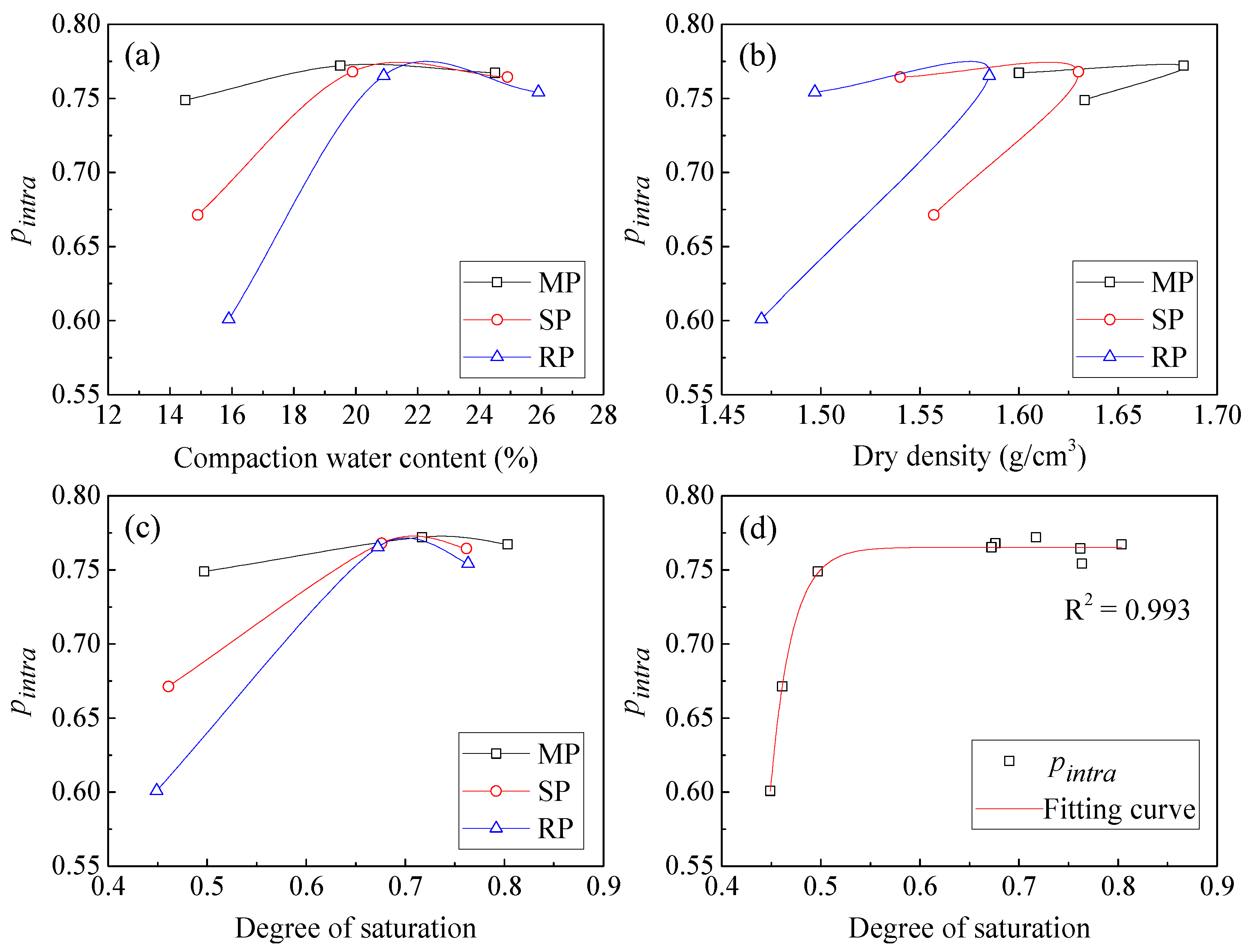
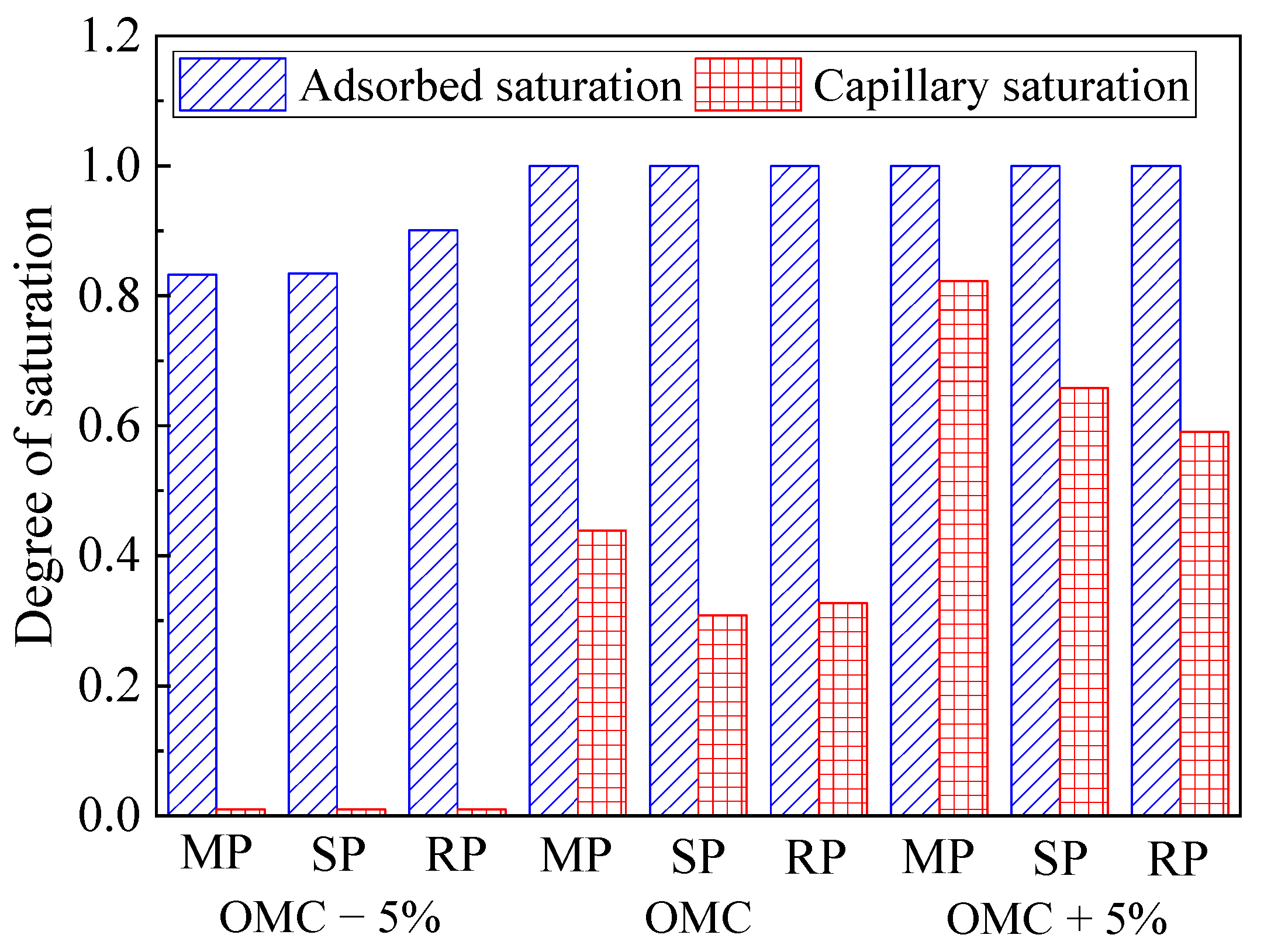
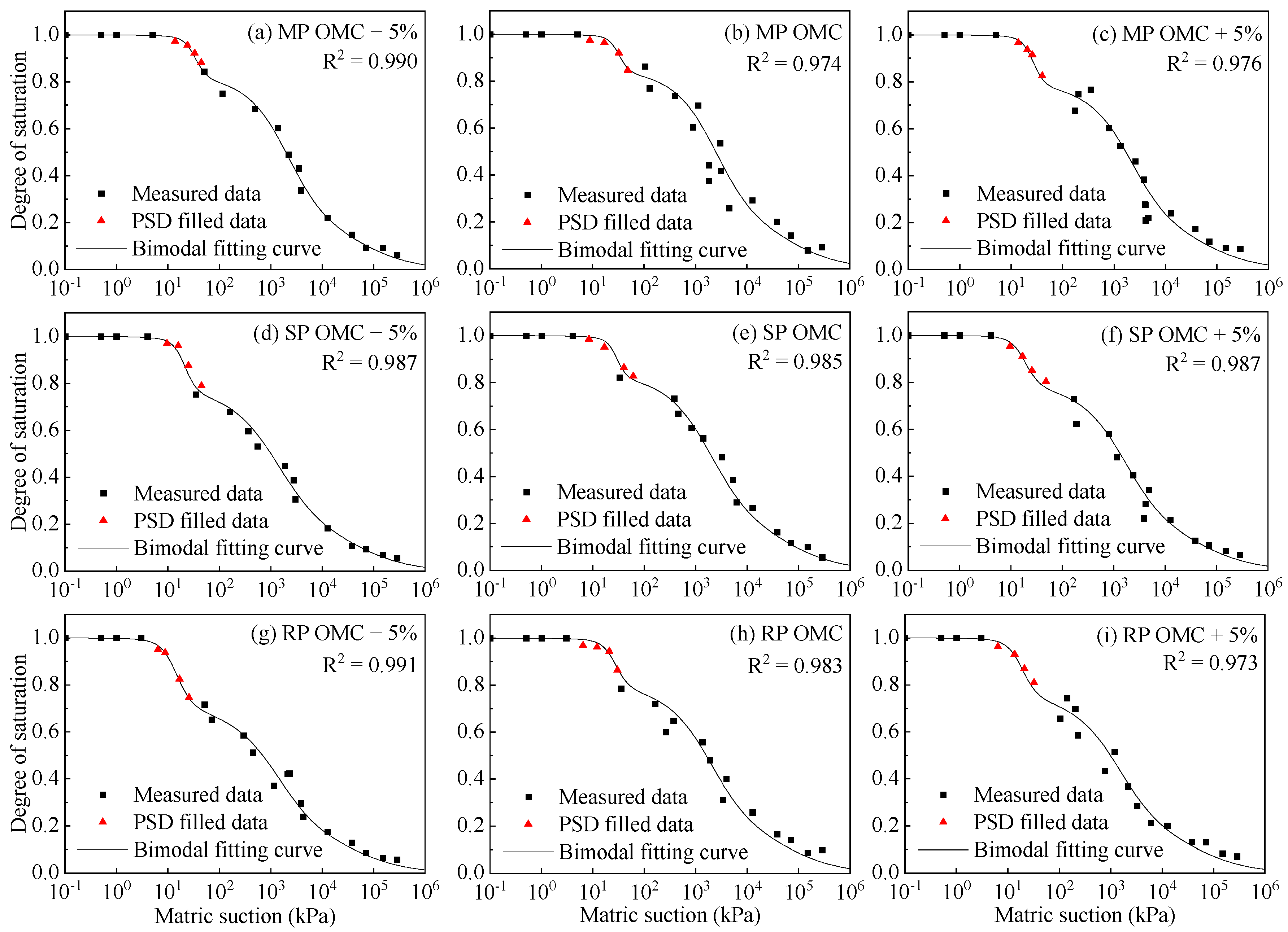
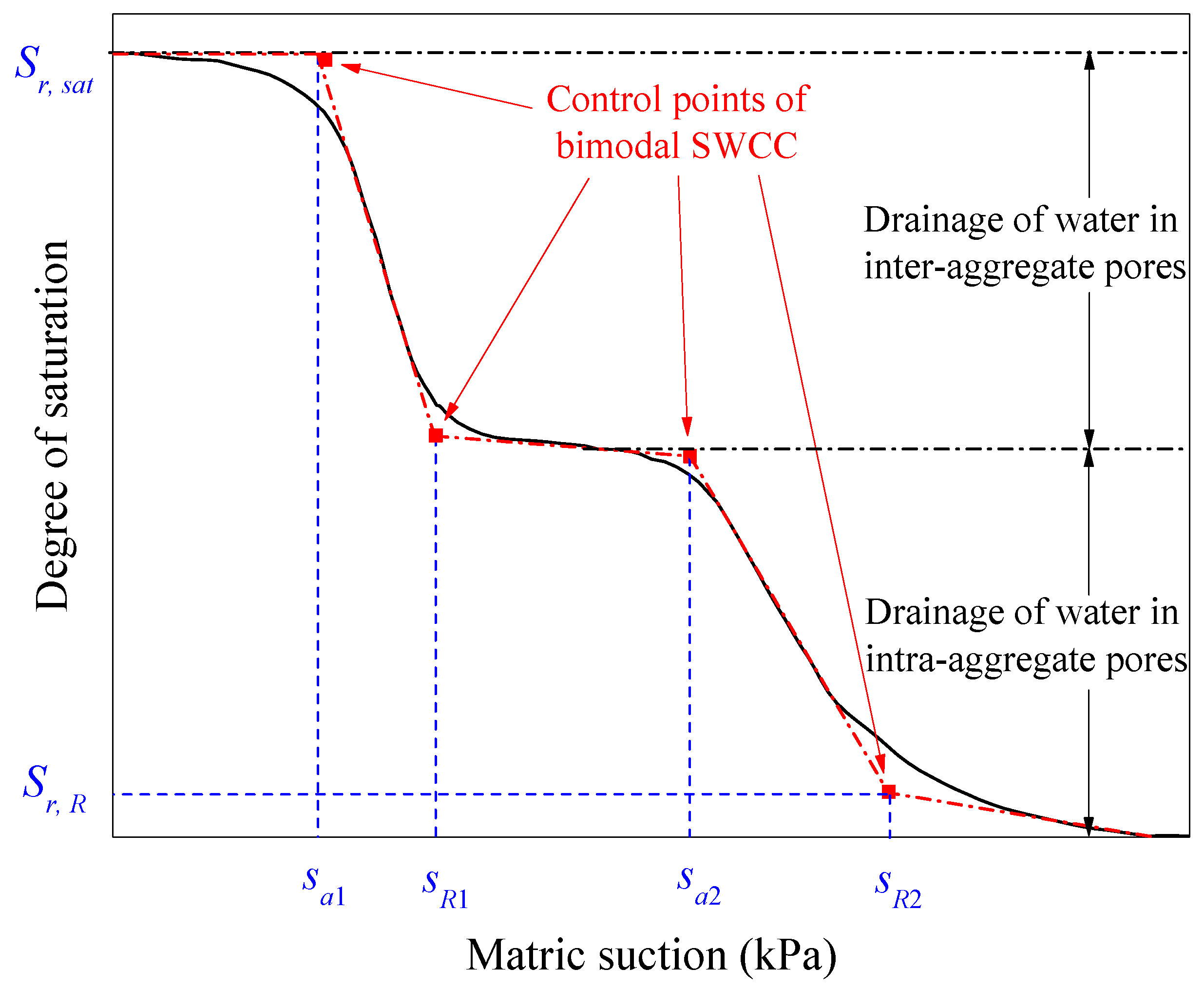

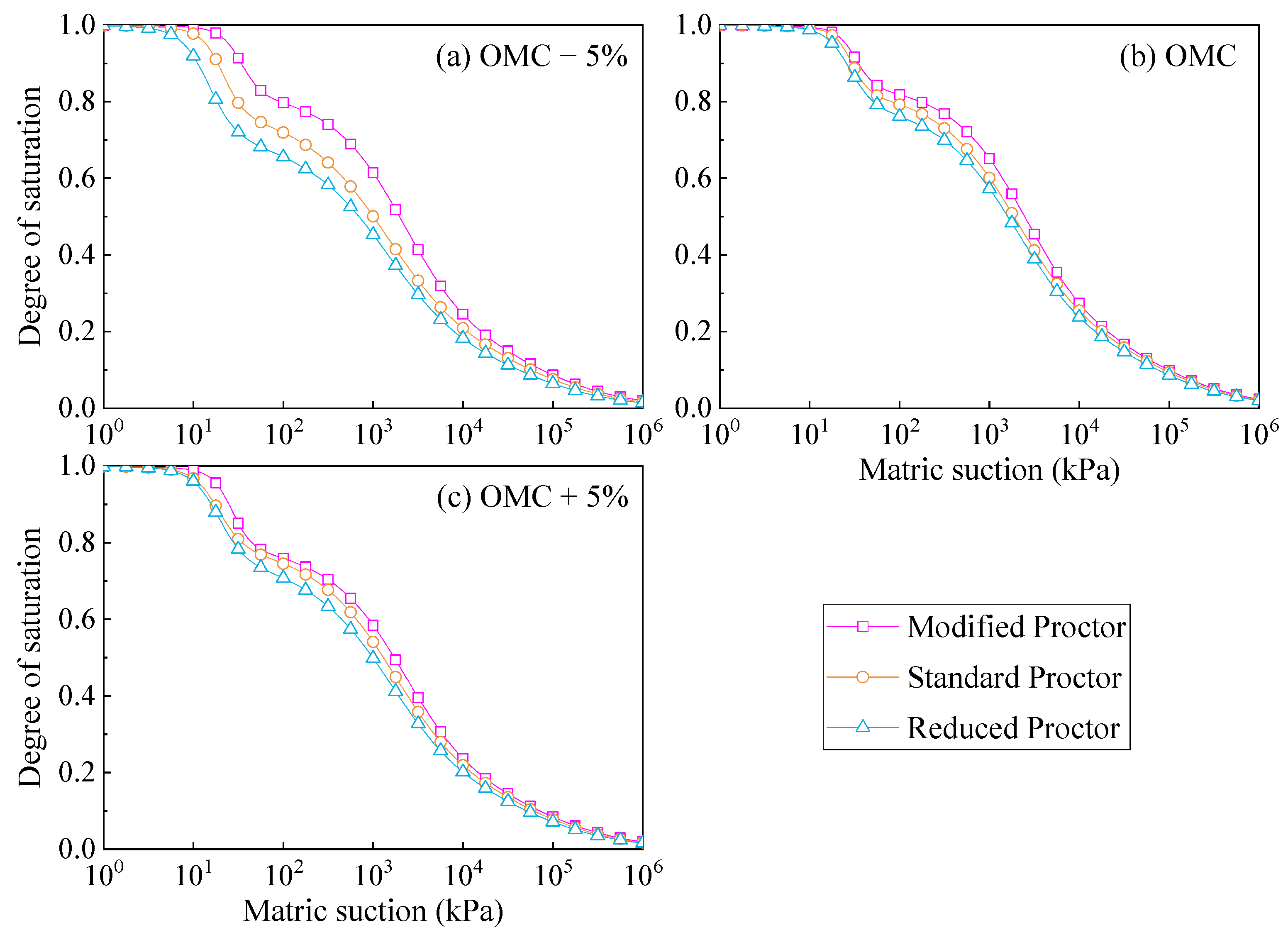
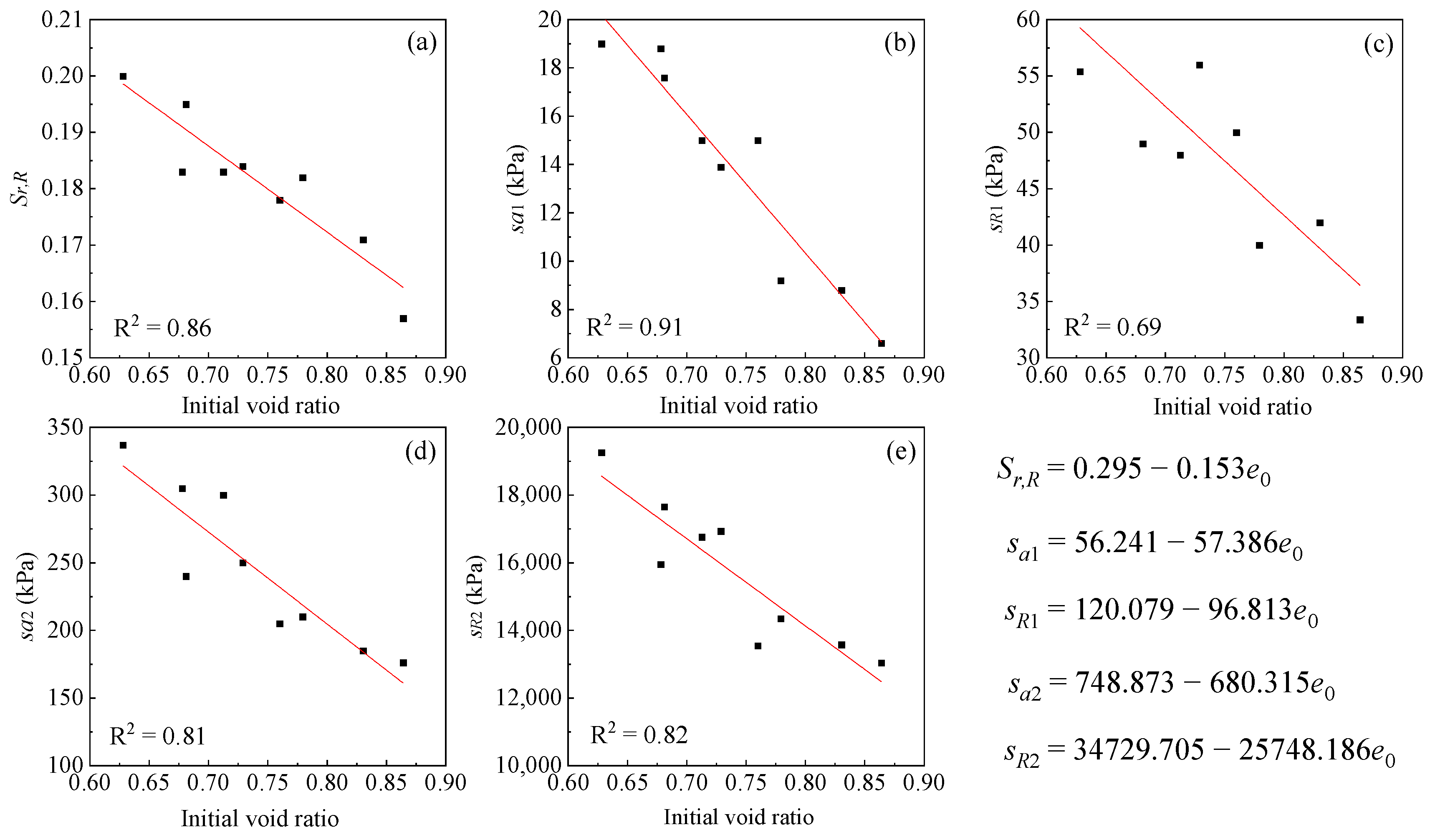
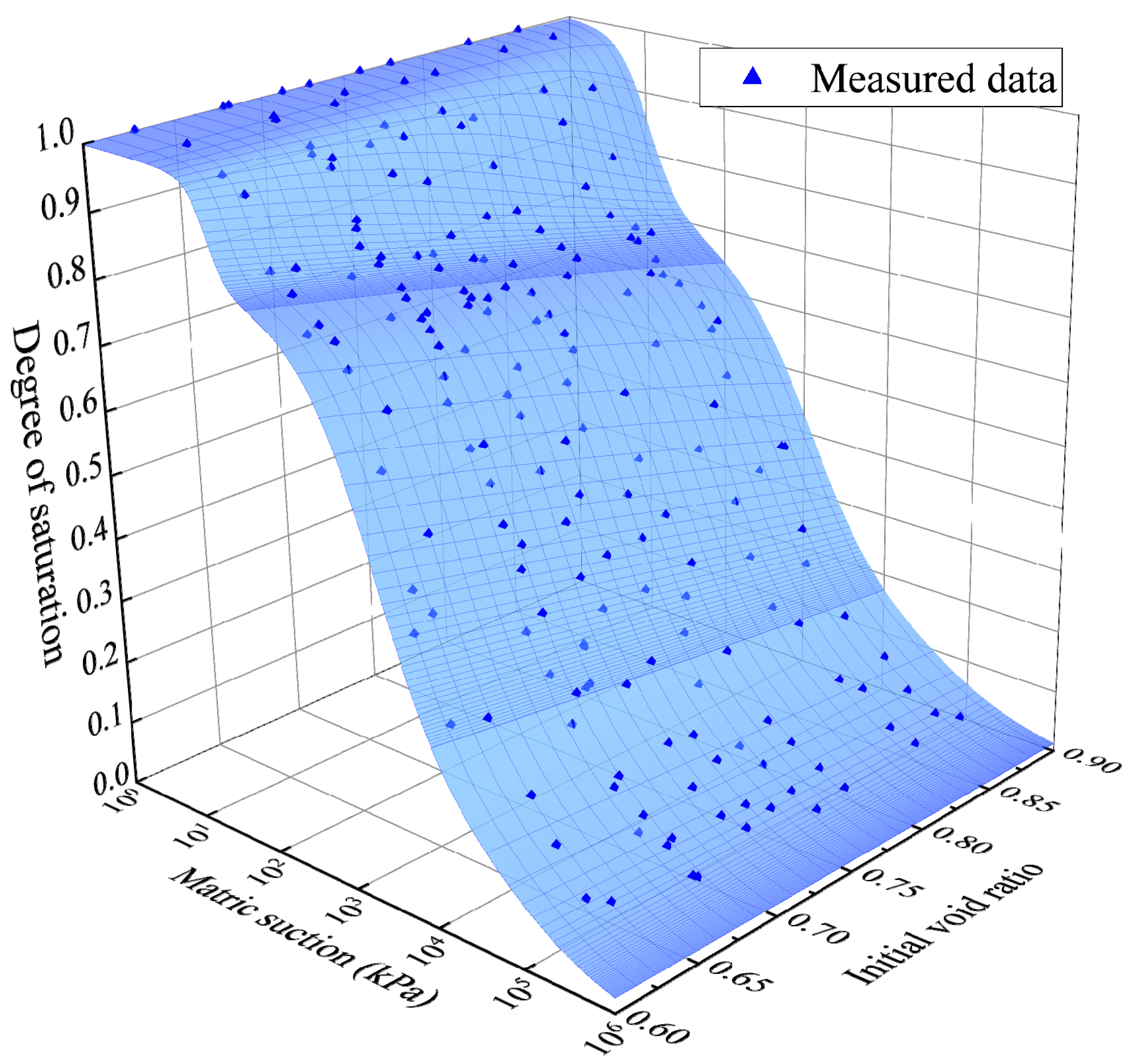
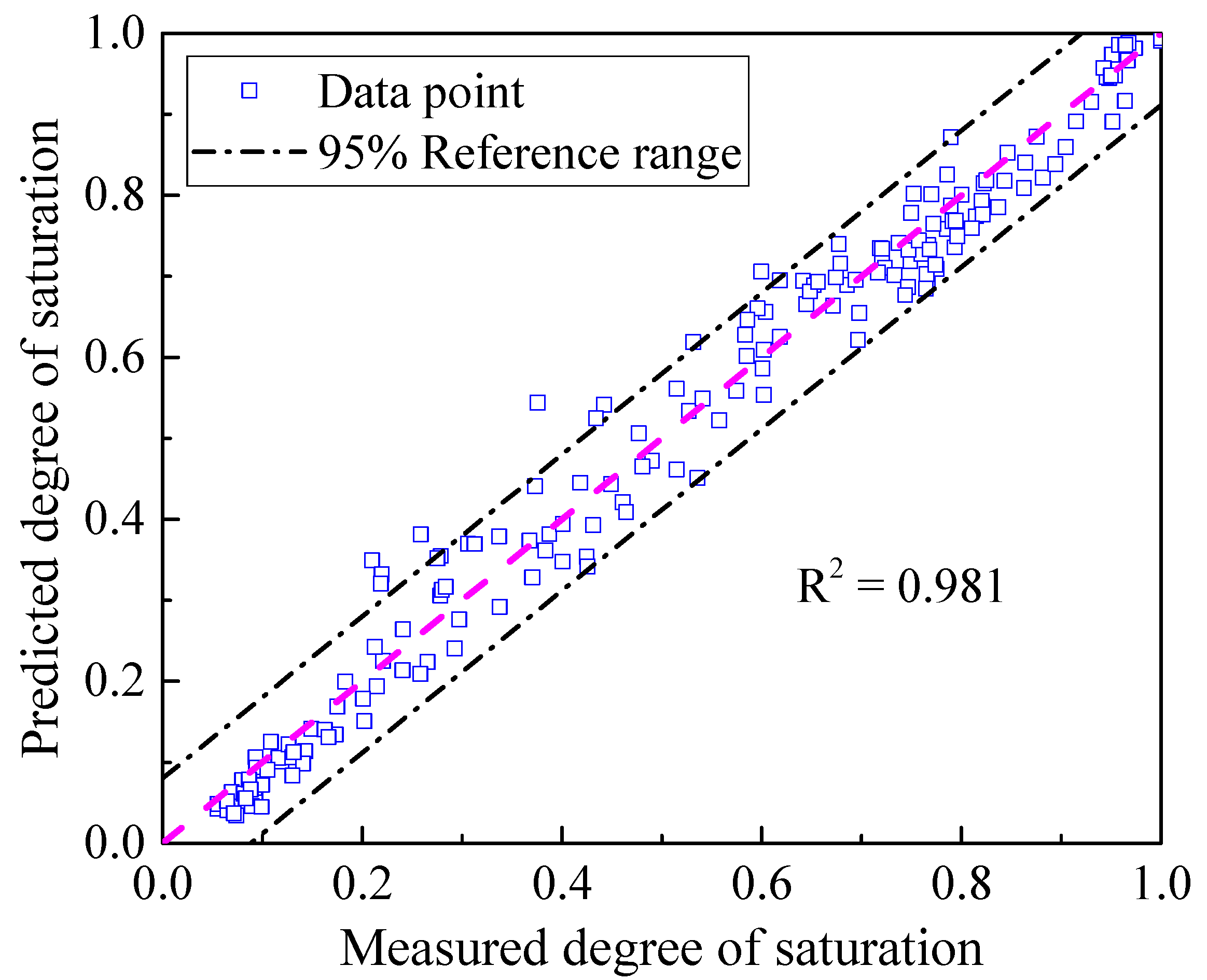
| Research | Equation | Parameters |
|---|---|---|
| Gallipoli et al. [35] | Sr: degree of saturation S: matric suction e: void ratio e0: initial void ratio w: gravimetric water content wsat: saturated gravimetric water content sr: residual matric suction n0: initial porosity Gs: soil gravity Ψ, φ, ng, mg, At, Bt, af, nf, mf = fitting parameters m: slope of segment i si: matric suction at the intersection between segment i and segment i−1 ki: curvature parameter between segment i and segment i−1 | |
| Tarantino [36] | ||
| Salager et al. [37] | ||
| Zhou et al. [38] | ||
| Wijaya and Leong [39] | |
| P0.075 (%) | w0 (%) | wp (%) | wl (%) | IP (%) | GS | Soil Classification |
|---|---|---|---|---|---|---|
| 62.8 | 29.0 | 22.0 | 62.0 | 40.0 | 2.74 | CH |
| Water Content Varies from OMC | −5% | −5% | −5% | 0 | 0 | 0 | +5% | +5% | +5% |
|---|---|---|---|---|---|---|---|---|---|
| Compaction water content (%) | 14.5 | 14.9 | 15.9 | 19.5 | 19.9 | 20.9 | 24.5 | 24.9 | 25.9 |
| Proctor type | MP | SP | RP | MP | SP | RP | MP | SP | RP |
| Dry density (g/cm3) | 1.63 | 1.56 | 1.47 | 1.68 | 1.63 | 1.58 | 1.60 | 1.54 | 1.50 |
| Initial void ratio | 0.68 | 0.76 | 0.86 | 0.63 | 0.68 | 0.73 | 0.71 | 0.78 | 0.83 |
| Salt Solution | ZnSO4 | NaCl | NaBr | MgCl2 | LiCl |
|---|---|---|---|---|---|
| Relative humidity (%) | 90.0 | 75.5 | 59.1 | 33.1 | 12.0 |
| Suction (MPa) | 12.6 | 38.0 | 71.1 | 149.5 | 286.7 |
| Initial Condition | Sr, sat | Sr, R | sa1 | sR1 | sa2 | sR2 |
|---|---|---|---|---|---|---|
| MP OMC − 5% | 1.0 | 0.183 | 18.8 | 62.0 | 305 | 15,947 |
| MP OMC | 1.0 | 0.200 | 19.0 | 55.4 | 337 | 19,257 |
| MP OMC + 5% | 1.0 | 0.183 | 15.0 | 48.0 | 300 | 16,758 |
| SP OMC − 5% | 1.0 | 0.178 | 15.0 | 50.0 | 205 | 13,545 |
| SP OMC | 1.0 | 0.195 | 17.6 | 49.0 | 240 | 17,650 |
| SP OMC + 5% | 1.0 | 0.182 | 9.2 | 40.0 | 210 | 14,346 |
| RP OMC − 5% | 1.0 | 0.157 | 6.6 | 33.4 | 176 | 13,034 |
| RP OMC | 1.0 | 0.184 | 13.9 | 56.0 | 250 | 16,936 |
| RP OMC + 5% | 1.0 | 0.171 | 8.8 | 42.0 | 185 | 13,575 |
Disclaimer/Publisher’s Note: The statements, opinions and data contained in all publications are solely those of the individual author(s) and contributor(s) and not of MDPI and/or the editor(s). MDPI and/or the editor(s) disclaim responsibility for any injury to people or property resulting from any ideas, methods, instructions or products referred to in the content. |
© 2024 by the authors. Licensee MDPI, Basel, Switzerland. This article is an open access article distributed under the terms and conditions of the Creative Commons Attribution (CC BY) license (https://creativecommons.org/licenses/by/4.0/).
Share and Cite
Chen, X.; Ma, M.; Zhou, S.; Hu, M.; Zhai, K.; Wei, S. Effect of Initial Conditions on the Pore Structure and Bimodal Soil–Water Characteristic Curve of Compacted Granite Residual Soil. Processes 2024, 12, 409. https://doi.org/10.3390/pr12020409
Chen X, Ma M, Zhou S, Hu M, Zhai K, Wei S. Effect of Initial Conditions on the Pore Structure and Bimodal Soil–Water Characteristic Curve of Compacted Granite Residual Soil. Processes. 2024; 12(2):409. https://doi.org/10.3390/pr12020409
Chicago/Turabian StyleChen, Xinran, Minglei Ma, Shumei Zhou, Mingjun Hu, Kejie Zhai, and Sen Wei. 2024. "Effect of Initial Conditions on the Pore Structure and Bimodal Soil–Water Characteristic Curve of Compacted Granite Residual Soil" Processes 12, no. 2: 409. https://doi.org/10.3390/pr12020409







